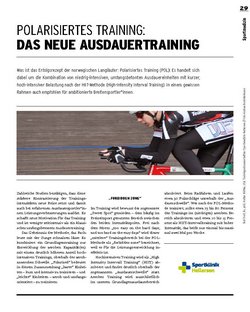WIR IM SPORT 07.2022
Magazine of the Landessportbund NRW
PDF-Download
What is the Norwegian cross-country skiers' recipe for success: polarized training (POL)! This is a combination of low-intensity, high-volume endurance units with short, high-intensity workouts using the HIIT (High-Intensity Interval Training) method. Also recommended to a certain extent for ambitious amateur athletes.
Numerous studies confirm that this greater contrast of training intensities creates new stimuli and thus also triggers performance improvements in experienced endurance athletes. It creates new motivation for training and is less time-consuming than classic endurance training with a focus on volume.
The secret of the method that has experts clicking their tongues: It combines basic training to develop aerobic capacity(s) with a significantly higher proportion of high-intensity training, above the aerobic-anaerobic threshold. In this context, "polarized" means "hard" units - short and intensive training - and "light" units - aerobic and volume-oriented training.
Forbidden Zone
During training, the so-called "sweet spot" - the area between the two intensity poles often used in recreational sports - is deliberately avoided. True to the motto "too easy on the hard days, and too hard on the easy days", this "middle" training range is referred to as the "forbidden zone" in the POL method because it is ineffective for performance development.
High-intensity training is carried out as "High Intensity Interval Training" (HIIT) and takes place well above the so-called "endurance threshold". Aerobic training is completed exclusively in the lower basic endurance range. When cycling and running, the heart rate is around 30 beats below the "endurance threshold". If you train using the POL method, you should complete around 75 to 80 percent of your training in the (low) aerobic zone and around 10 to 15 percent as high-intensity HIIT interval training, i.e. only once or twice a week at most.


